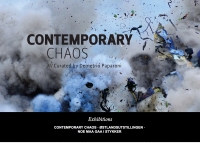2018
Contemporary Chaos
di Elena Di Raddo
Non sono i soggetti a definire il senso della pittura di Letizia Fornasieri, quanto l’approccio visivo alla realtà osservata: un tema che appartiene alla storia dell’arte stessa, inaugurato nell’epoca moderna da Cézanne. Il taglio estremamente ravvicinato al soggetto naturale, attraverso il quale si percepisce la liquidità del colore, l’imperfezione dei dettagli e la matericità di alcuni punti più spessi intarsiati da colpi di pennello piatto, rivela appunto il problema, tutto interno al fare pittura, della “distanza”. In tutte le opere di Letizia Fornasieri, anche quelle che rappresentano interni di case, scorci di strade o ritratti, dove talvolta è solo il riflesso in un vetro a determinare l’immagine, il punto di osservazione della realtà è determinante perché contribuisce a creare un rapporto più intimo e mediato con quanto è raffigurato.
L’osservazione ravvicinata del dato naturale, presente, oltre che nelle opere che raffigurano, come questa, la campagna padana anche nella serie dedicata al paesaggio senese, fa pensare all’eredità dalla pittura paesaggistica lombarda, ma il lavoro di Letizia Fornasieri non è inquadrabile nel “realismo” di quella corrente. Il suo approccio al dato reale è mediato da un problema che potremmo definire fotografico. Prima di arrivare alla serie delle “Rogge”, cui questo dipinto appartiene, Fornasieri ha sperimentato in alcuni lavori l’uso della fotografia riportata su tela e rielaborata con la pittura. Abbandonato quel procedimento è tornata alla pittura pura, scegliendo però un supporto che possiede quella “memoria fotografica”, una tela dalla grammatura molto fine, che permette di ottenere effetti di lucentezza e liquidità al colore, che enfatizzano i riflessi e il senso di precarietà dell’immagine. Con questa sua pittura l’artista riesce così a comunicarci che la realtà è sempre mediata, perché il nostro sguardo è condizionato dal nostro essere nella realtà.
It is not the subjects that define the meaning of Letizia Fornasieri’s works, but rather the visual approach to observed reality: a theme that belongs to the history of art itself, initiated in the modern era by Cézanne. The extremely up close aspect of the natural subject (through which the liquidity of the color is perceived), the imperfection of the details, and the materiality of certain thicker points embellished by flat brushstrokes reveal a problem that is entirely internal to painting: that of ‘distance’. In all of Fornasieri’s paintings – even those that depict the interiors of houses, glimpses of streets, or portraits, in which at times it is only a reflection in glass that defines the image – the point of observation of reality is crucial, as it contributes to creating a more intimate and mediated relationship with what is portrayed.
While her up close observation of the natural and immediate object is reminiscent of the legacy of Lombardy landscape painting – not least in those works in the series devoted to the Siena landscape which, like this one, depict the countryside of the Po Valley – Letizia Fornasieri’s work does not the ‘realism’ of this trend. Her approach to the real figure is mediated by a problem which we might define as photographic. Before beginning the ‘Rogge’ series, to which this painting belongs, Fornasieri experimented in several of her works with the use of photography placed on canvas and reworked through painting. After abandoning this technique, she returned to pure painting, while employing a support which possesses the ‘photographic memory’: a very fine weight canvas, which enhances the luster and liquidity of the colors and accentuates the reflections and the sense of precariousness of the image. In this way, the artist is able to express that reality
